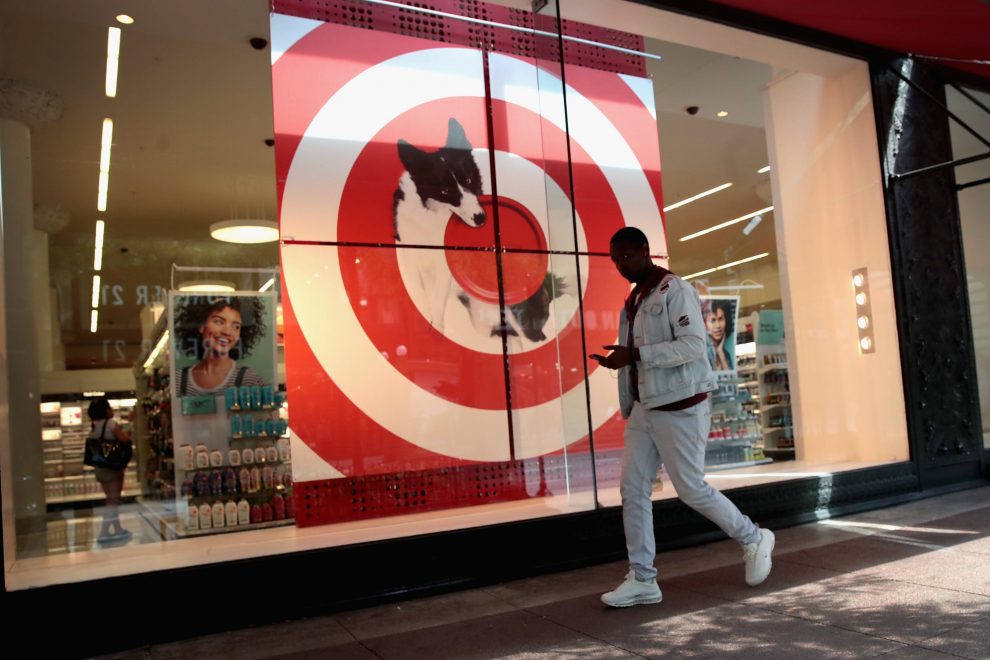
Target‘s digital sales fueled first-quarter gains, but the big-box retailer’s earnings results Wednesday showed it paid a hefty price for that growth as labor costs rose and sales of higher-margin items like apparel dropped.
Shares were up less than 1% in premarket trading.
Target stores have remained open across the country during the coronavirus pandemic, but the crisis has underscored the challenge of making money from e-commerce. As retailers sell more online, they’re also taking on more work, such as picking items, packing them and shipping them. That typically squeezes their profits —whether retailers fill an order for curbside pickup, mail it or deliver it to customers’ doors.
Here’s what Target reported for the first quarter ended May 2:
- Earnings per share: 59 cents, adjusted
- Revenue: $19.62 billion
- Same-store sales: up 10.8%
In late April, Target warned the company’s increased expenses — such as higher pay for workers — would pressure its profits for the quarter, sparking a stock sell-off.
The cost of the increased wages, store cleaning and other expenses related to the pandemic has totaled about $500 million, CEO Brian Cornell told reporters during an earnings call. That includes $2 per hour wage increases and and improved benefits that will be paid through July 4.
Target said first-quarter net income fell to $284 million, or 56 cents per share, from $795 million, or $1.53 per share, a year earlier. Excluding some items, Target earned 59 cents per share. Analysts were expecting Target would earn 40 cents per share, according to Refinitiv.
The company’s revenue rose 11.3% to $19.62 billion, from $17.63 billion a year earlier, beating analysts’ estimate of $19.04 billion.
Target’s same-store sales grew by 10.8% in the first quarter from a year earlier. The vast majority of that growth came from e-commerce. Sales at stores open at least 12 months rose 0.9%, while digital sales surged by 141%.
The company withdrew its financial outlook for the full-year and first quarter in late March because of Covid-19. It has not provided a second-quarter or annual forecast.
Bigger baskets, fewer trips
During the quarter, Target said customers’ average basket was 12.5% higher as they made fewer trips to the store. Its digital surge was sudden and significant. Each month of the period, the company said its digital sales growth accelerated, from 33% in February to about 100% in March to 282% in April.
Target’s margins were squeezed as many shoppers skipped over more profitable apparel and accessories and gravitated toward lower-margin categories, such as food and essentials.
The retailer’s strongest merchandise category was what it calls hardlines, which includes durables like appliances. The category grew by more than 20% from the previous year, fueled by electronics sales, Cornell said. Food and beverage grew by more than 20%. Essentials and beauty were up by the high-teens.
But apparel was down by about 20%, he said.
Customers’ shift online has increased costs, but the retailer has tried to manage them by using its many stores as a fulfillment centers. The company said nearly 80% of its first-quarter digital sales were fulfilled by stores.
Its same-day services were especially popular, growing by 278% in the quarter. Target allows customers several ways to get their online orders on the day of purchase: They can pick them up in stores, drive up to a store to retrieve them or get them delivered to the door by Target-owned service, Shipt.
Those services accounted for about 5% of its same-store sales growth for the quarter, the company said.
Winning new customers
Despite higher costs, Cornell said the retailer is attracting new customers and inspiring loyalty that will pay off for the long term.
He said 5 million new customers shopped at Target.com and over 2 million tried its drive-up service for the first time in the quarter. He added that over 70 million people have now signed up for Target Circle, its smartphone app, as the company tries to position itself as a safer place to shop.
“We’ll continue to be focused on safety, not just for the next few quarters, but for years and years to come,” he said. “We’ve been talking for years about being America’s easiest place to shop. We’re going to need to make sure we combine being an easy place to shop with America’s safest place to shop and make sure that that commitment to safety is ongoing.”
He said Target saw hopeful glimmers toward the end of the quarter, as shopping for discretionary items like clothing picked up — in part because of stimulus checks and more customers leaving their homes as lockdowns lifted. April was also its best month of the three-month period, with same-store sales up by over 16% from a year earlier.
And sales trends also reflected people’s new priorities, such as more cooking at home. While same-store sales in the home category were only up in the single digits, sales of kitchen items jumped by more than 25%.
Still, he acknowledged it’s difficult to plan for the future. He said Target doesn’t know what will happen with the back-to-school season, for example, as college students wait to hear if they’ll move into dorms and return to campuses, or how people will celebrate holidays as the pandemic continues.
And, he said, the economic picture is unclear, especially with rising unemployment.
“Right now, we know that consumers are living differently,” he said. “They’re shopping differently. They’re adapting to the new environment, so it’s really a time of uncertainty and it’s why we’re making sure we’re as flexible as possible.”
He said he expects shoppers to seek out convenient, contactless approaches.
“There’s going to be a premium on creating a safe, sanitized shopping environment,” he said.











Add Comment